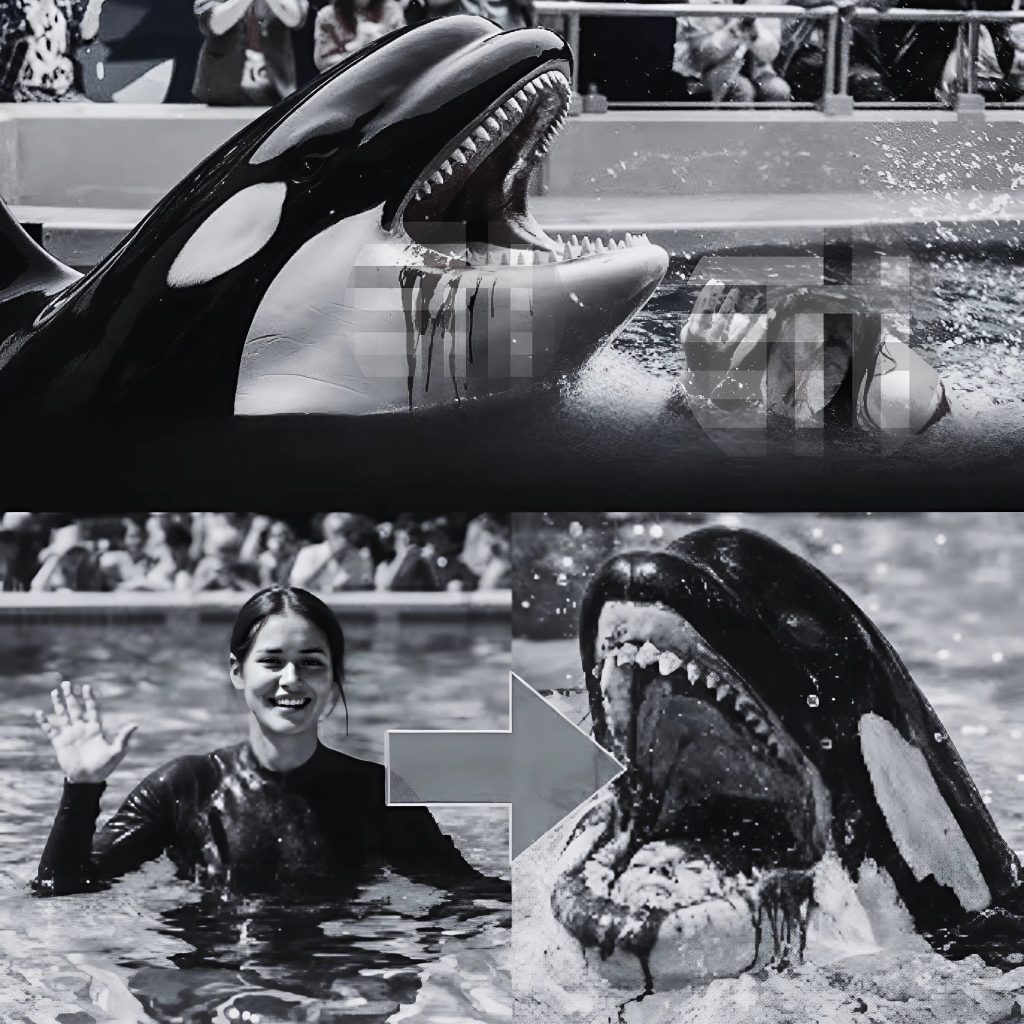
In the haunting continuation of the Killer Whale’s Revenge saga, a disturbing photo has surfaced, fueling the ongoing debate about the ethics of marine life captivity. The image, taken just moments before a brutal attack at a marine theme park, captures the icy gaze of an orca toward its trainer—a stare many now interpret as a chilling glimpse into the deep resentment and suffering these intelligent marine mammals endure. This third installment of the Killer Whale’s Revenge series highlights not only the dangers of keeping orcas in captivity but also the growing body of evidence that suggests these majestic animals are far more emotionally aware than once believed.
Orcas, also known as killer whales, are apex predators with complex social structures and extraordinary intelligence. In the wild, they travel in tight-knit pods, cover vast distances daily, and communicate using highly sophisticated vocalizations. When confined to concrete tanks and forced to perform for crowds, their natural behaviors are suppressed, often leading to psychological stress and unpredictable aggression. The infamous photo at the center of this story has become symbolic of this internal torment. It shows the orca surfacing slowly, its eyes locked on the trainer with a look that many marine biologists and animal behaviorists have described as “calculating,” “haunted,” and “full of suppressed rage.”

The orca in the photograph, known as Kairo, had been in captivity for over fifteen years. Originally taken from the wild as a calf, Kairo was separated from his pod and sold to a theme park where he spent most of his life performing repetitive tricks for fish and applause. While trainers and park officials insisted Kairo was well-treated and content, former employees began to speak out after the incident, revealing a much darker side of the marine park’s operations. Leaked internal reports detailed signs of deteriorating mental health in Kairo: refusal to perform, extended periods of motionlessness, and increasing aggression toward other orcas. These behaviors were largely ignored until the tragic event that the photo now represents.
The attack occurred during a routine afternoon show, witnessed by hundreds of horrified spectators. The trainer, a seasoned performer with years of experience, had just completed a trick sequence when Kairo suddenly lunged. What followed was a chaotic, violent scene that ended with serious injuries and a renewed call for the end of orca captivity. While park officials initially dismissed the attack as an isolated incident, marine mammal experts argue otherwise. They point to mounting evidence that orcas in captivity often display signs of psychological trauma, including teeth grinding, self-harm, and sudden aggression toward humans.
This latest attack marks the third documented incident in the Killer Whale’s Revenge series, each more brutal and heartbreaking than the last. The photo’s viral spread has reignited global outrage, forcing the marine park industry to face increasing public scrutiny. Activists and advocacy groups have used the image as a rallying cry, demanding stricter laws and ultimately a ban on keeping orcas and other large marine mammals in captivity. The sentiment is echoed by many marine scientists who argue that no artificial environment can replicate the physical, emotional, and social stimulation these animals experience in the wild.
Public opinion is shifting rapidly. Attendance at marine parks has declined, and more people are choosing to support ocean sanctuaries—protected, open-water environments where retired orcas can live out their lives in peace. Several countries have already passed legislation banning or restricting orca captivity, and the conversation is gaining momentum across the globe. The photo of Kairo, with its piercing expression and ominous undertone, has become an icon for this movement. It serves as a powerful reminder that beneath the surface of these seemingly calm and obedient performers lies a complex being capable of emotion, memory, and perhaps even vengeance.

While the debate continues, what cannot be denied is the profound impact this chilling image has had. It humanizes the plight of captive orcas in a way words alone never could. It captures a fleeting but potent moment of truth—an unfiltered look into the soul of a creature pushed beyond its limits. For many, it is no longer a question of whether these animals should be freed, but how soon it can happen. Each passing day in captivity is a day stolen from their rightful place in the wild.
Kairo’s story, now etched in public memory, joins the growing list of tragedies that challenge the morality of animal entertainment. The killer whale’s revenge is not merely about an animal lashing out; it’s a reflection of a broken system—one that prioritizes profit over well-being and performance over compassion. As the world awakens to this reality, it’s clear that change is not only necessary but inevitable. The photo may have frozen a moment in time, but its message continues to ripple outward, forcing a long-overdue reckoning with the way we treat the sentient creatures we claim to admire.